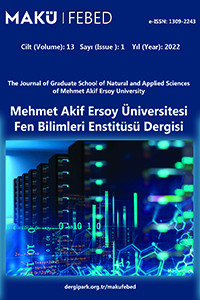Antalya Bölgesindeki İstilacı Bir Salyangoz Türünün Moleküler Filogenisi
Gastropoda, Xeropicta, COI, Antalya, Filogeni
___
- Aubry, S., Labaune, C., Magnin, F., Kiss, L.( 2005) Habitat and integration within indigenous communities of Xeropicta derbentina (Gastropoda:Hygromiidae) a recently introduced land snail in South-eastern France. Diversity and Distributions 11: 539-547.
- Dükel M. (2010) Graecoanatolica türlerinin moleküler sistematik açıdan araştırılması (Yüksek Lisans Tezi) Mehmet Akif Ersoy Üniversitesi, TR
- Ergüden D. (2007) Türkiye denizlerindeki tirsilerin (Alosa spp.) moleküler sistematiği (Doktora Tezi) Çukurova Üniversitesi, TR
- Folmer, O., Black, M., Hoeh, W., Lutz, R., Vrijenhoek, R. (1994) DNA primers for amplification of mitochondrial cytochrome c oxidase subunit I from diverse metazoan invertebrates. Molecular Marine Biology and Biotechnology 3: 295-299.
- Godfray, H.C.J., Clark, B.R., Kitching, I.J., Mayo, S.J., Scoble, M.J. (2007) The Web and the structure of taxonomy. Society of Systematic Biologist 56: 943-955.
- Henning, B.W. (1965) Phylogenetic Systematics. Annu Rev Entomol 10:97-116.
- Kebapçı Ü. (2007) Kuzeybatı Anadolu’nun karasal gastropodları (Doktora Tezi) Süleyman Demirel Üniversitesi, TR
- Keeton, W.T., Gould, J.L., Gould, C.G. (1999) Biological Science. W.W. Norton and Company, London.
- Liu, P.H., Hershler, R., Clift, K. (2003) Mitochondrial DNA sequences reveal extensive cryptic diversity within a western american springsnail. Molecular Ecology 12: 2771-2782.
- Patwardhan, A., Ray, S., Roy, A. (2014) Molecular markers in phylogenetic studies –A review. J Phylogen Evolution Biol 2: 1-9.
- Remigio, E.A., Hebert, P.D.N (2003) Testing the utility of partial COI sequences for phylogwnwtic estimates of gastropod relationships. Molecular phylogenetics and Evolution 29: 641-647.
- Sereno, P.C. (2005) The logical basis of Phylogenetic Taxonomy. Society of Systematic Biologist 54: 595-619.
- Kurabayashi, A., Ueshima, R. (2000) Complete sequence of the mtDNA of the primitive opisthobranch gastropod Pupa strigosa: systematic implication of the genom organisation. Molecular Biology Evolution 17: 266-277.
- Wilke, T., Davis, G.M., Qiu, D., Spear, R.C. (2006) Extreme mitochondrial sequence diversity in the intermediate Schistosomiasis host Oncomelania Hupensis Robertsoni : Another case of ancestral polymorphism? Malacologia 48: 143-157.
- Yayın Aralığı: Yılda 2 Sayı
- Başlangıç: 2010
- Yayıncı: Burdur Mehmet Akif Ersoy Üniversitesi
Kuyu Suyunda Bazı Kalite Parametrelerinin Belirlenmesi: Bartın Örneği
Betül Tuba GEMİCİ, Cengiz YÜCEDAĞ, Eray KARAKOÇ, Derviş ALGUR
Antalya Bölgesindeki İstilacı Bir Salyangoz Türünün Moleküler Filogenisi
Ayşe MUTLU, Abdülkerim BİLGİNER, Muzaffer DÜKEL, Ümit KEBAPÇI, Duygu ÇAĞLAN, Mehmet YILDIRIM
Kablosuz Algılayıcı Ağlar için Güç Tasarruflu Ağ Geçidi Tasarımı
Mehmet YÜKSEL, Asım YÜKSEL, Recep İBİLOĞLU
Kompozit Yapı Sistemlerinin İncelenmesi
Gülhan İNCE, Hüseyin İNCE, Fatih KAYA
Demiryolu Üstyapısında Balast Kirliliği
